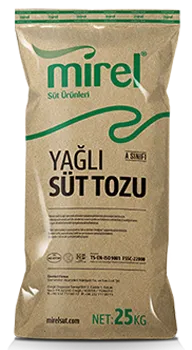Milk powder is a dried dairy product obtained by evaporating as much of the water as possible from fresh, fat and fat-free milk. The biggest advantage of milk powder is that high amounts of milk powder are lighter than the same amount of milk and can be stored more easily, so it is more convenient to transport and store than milk, and it is also cheaper. Contrary to popular belief, milk powder does not dissolve in hot water. Like every dairy product, milk powder is a dairy product and does not contain any additives. When needed, it can be converted back into milk (reconstituted milk) and processed into dairy products (recombined product). According to FAO and WHO standards, milk powders are divided into 3 classes:
1.Whole Milk Powder (fat: at least 26%, water: at most 5%)
2. Low-fat Milk Powder (fat: 1.5-26%, water: maximum 5%)
3.Fat Milk Powder (fat: maximum 1.5%, water: maximum 5%)
How to Obtain Milk Powder?
It is obtained by evaporating almost all of the liquid in the milk at the appropriate temperature and pressure, without destroying the proteins and useful elements it contains. Milk powder production is generally made using spray dryers, preferably from skim or fatty milk. Pasteurized milk is thickened in evaporators until 50% solids remain. The thickened milk is pulverized in spray dryers to obtain milk powder. Freeze drying method can also be used to obtain milk powder. While this process preserves the nutritional value of milk more than the drum dryer, it is not preferred due to the expense of the system used.
Where is Milk Nozzle Used?
1. Milk powder is sold to consumers because it is soluble in water. By adding water to milk powder in a ratio of 1 to 9, a product with normal milk consistency can be obtained. In places where milk supply or milk storage is difficult, consumption of milk powder is preferred.
2. Since milk powder gives the same flavor as milk but is cheaper than using milk, milk powder is often preferred in sectors where milk is used. In addition, milk powder is preferred due to the suitability of storage conditions and the absence of spoilage of the product.
3. In food aid to countries such as Africa, milk powder is preferred for food safety and economic reasons in order to deliver the nutritional value of milk to those people.
4. In cake and dough processes, milk powder can be added when liquid milk is not desired to dilute the product too much for product quality.
5. Milk powder is effective in the production of baby foods.
6. Powdered milk is used to prepare the ingredients of dried ready-made products such as instant soup.
7. Milk powder is added to most foods prepared for animals.
8. The ingredients of coffee creamers are made using milk powder.
9. Milk powder is used as a thickener in most businesses that produce ice cream, candy, cheese and yoghurt using milk.

